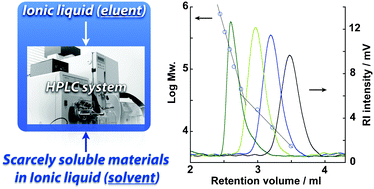
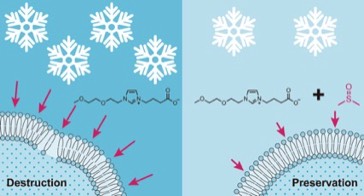
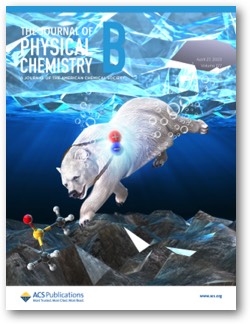
55.
Optimization of zwitterionic polymers for cell cryopreservation
Y. Kato, T, Uto, T. Ishizaki, D. Tanaka, K. Ishibashi, Y. Matsuda, I. Onoda, A. Kobayashi, M. Hazawa, R. W. Wong, K. Takahashi, E. Hirata, K. Kuroda*
Macromol. Biosci, 202300499 (2024)
Front Cover
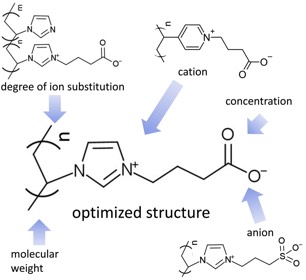
54.
Protein Cryoprotectant Ability of the Aqueous Zwitterionic Solution
T. Takekiyo*, S. Yamada*, T. Uto, M. Nakayama, T. Hirata, T. Ishizaki, K. Kuroda*, Y. Yoshimura
J. Phys. Chem. B, 128, 526-535 (2024)
53.
Cell-compatible isotonic freezing media enabled by thermo-responsive osmolyte-adsorption/exclusion polymer matrices
Y. Kato, Y. Matsuda, T. Uto, D. Tanaka, K. Ishibashi, T. Ishizaki, A. Ohta, A. Kobayashi, M. Hazawa, R. W. Wong, K. Ninomiya, K. Takahashi, E. Hirata, K. Kuroda*
Commun. Chem., 6, 260 (2023)
2023 Editors' highlight
Open Access
52.
Aryloxy ionic liquids-catalyzed homogenous esterification of cellulose with low-reactive acyl donors
A. Yoshizawa, C. Maruyama, S. B. W. Kusuma, N. Wada , K. Kuroda, D. Hirose*, K. Takahashi*
Polymers, 15, 419 (2023)
Open Access
We have previously succeeded in esterification of cellulose by using carboxylate-type ionic liquids as "solvents" and "catalysts", but a side reaction—anions of the ionic liquid bind to the cellulose— occurs. By using pyridinolate anions, the side reaction was suppressed.
51.
Cryopreservation of tissues by slow-freezing using an emerging zwitterionic cryoprotectant
T. Ishizaki, Y. Takeuchi, K. Ishibashi, N. Gotoh, E. Hirata*, K. Kuroda*
Sci. Rep., in press (2023)
Open Access
Zwitterion/DMSO mixtures well cryopreserved spheroids (cell aggregates). They showed high cryoprotecting effect for mouse/human cancer tissues.
50.
A simple overview of toxicity of ionic liquids and designs of biocompatible ionic liquids
K. Kuroda*
New J. Chem., 46, 20047-20052 (2022)
Front Cover
Open Access
This perspective reviews the toxicity of ionic liquids systematically but as simple as possible. The design of biocompatible ionic liquids was also mentioned.
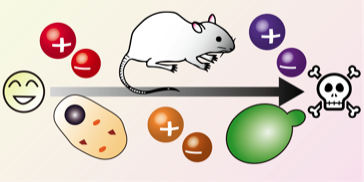
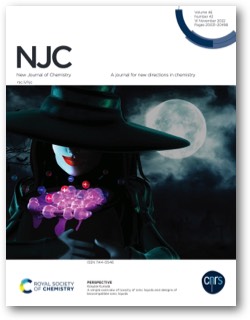
49.
Reducing cellulose crystallinity with a non-cellulose-dissolving solid zwitterion and its application for biomass pretreatment
A. Hachisu, H. Tobe, K. Ninomiya, K. Takahashi, K. Kuroda*
ACS Sustain. Chem. Eng., 10, 6919-6924 (2022)
A solid zwitterion which does not dissolve cellulose was able to decrease crystallinity of cellulose. It pretreated biomass efficiently, like a liquid zwitterion which dissolve cellulose.

48.
Cryostorage of unstable N-acetylglucosaminyltransferase-V by synthetic zwitterions
T. Hirata*, T. Takekiyo*, Y. Yoshimura*, Y. Tokoro, T. Ishizaki, Y. Kizuka, K. Kuroda*
RSC Adv., 12, 11628-11631 (2022)
Open Access
Artificial zwitterions were applied to cryopreservation of proteins. In this study, unstable GnT-V (glycosyltransferase, related to cancer metastasis) was well cryopreserved.
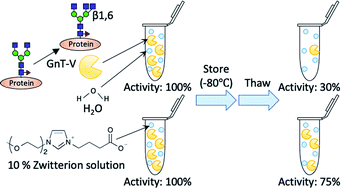
47.
Characterization and Application of Carboxylate-type zwitterions synthesized by one-step
T. Komori, Y. Kato, K. Ishibashi, K. Ninomiya, N. Wada, D. Hirose, K. Takahashi, E. Hirata, K. Kuroda*
J. Ion. Liq., 2, 100027 (2022)
Open Access
A carboxylate-type zwitterion was synthesized in one-step by using a ring-opening reaction of beta-propiolactone. The zwitterion dissolved cellulose but not thermally much stable. Therefore, we here applied it as a cryoprotective agent and it was useful.

46.
Synthesis of a cellulose dissolving liquid zwitterion from general and low-cost reagents
G. Sharma, Y. Kato, A. Hachisu, K. Ishibashi, K. Ninomiya, K. Takahashi, E. Hirata, K. Kuroda*
Cellulose, 29, 3017-3024 (2022)
The specific zwitterion (called OE2imC3C) has been reported as the most biocompatible cellulose solvent by us in 2017 (see No. 20 and 29). However, one of the reagent for the synthesis is very expensive and sometimes out of order. We here developed the synthetic route of the zwitterion with low-cost and general reagents.
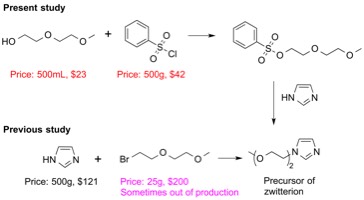
45.
Synthetic zwitterions as efficient non-permeable cryoprotectants
Y. Kato, T. Uto, D. Tanaka, K. Ishibashi, A. Kobayashi, M. Hazawa, R. W. Wong, K. Ninomiya, K. Takahashi, E. Hirata*, K. Kuroda*
Commun. Chem., 4, 151 (2021)
Open Access
We have reported that a synthetic zwitterion (called OE2imC3C) works as a cryoprotectant (see No. 39). However, the mechanisms of cryopreservation has not been clarified. We here investigated the mechanisms. Furthermore, the mixtures of zwitterion/dimethyl sulfoxide efficiently cryopreserved freezing-vulnerable cells.
44.
Essential requirements of biocompatible cellulose solvents
T. Komori, H. Satria, K. Miyamura, A. Ito, M. Kamiya, A. Sumino, T. Onishi, K. Ninomiya, K. Takahashi, J. L. Anderson, T. Uto*, K. Kuroda*
ACS Sustain. Chem. Eng., 9, 11825-11836 (2021)
The specific zwitterion (called OE2imC3C) has been reported as the most biocompatible cellulose solvent by us in 2017 (see No. 20 and 29). However, analogous zwitterions have not been investigated. Here we concluded that the requirements for low-toxic cellulose solvents are zwitterionic structures, carboxylate anions, long polar cation tails, and in some cases, short spacers.
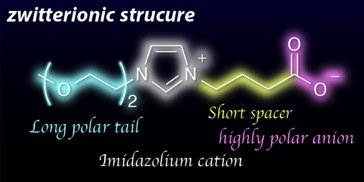
43.
Cellulose preferentially dissolved over xylan in ionic liquids through precise anion interaction regulated by bulky cations
R. Kadokawa, T. Endo, Y. Yasaka, K. Ninomiya, K. Takahashi, K. Kuroda*
ACS Sustain. Chem. Eng., 9, 8686-8691 (2021)
Supplementary Cover
The ionic liquids, designed with polar anions and bulky cations, dissolved cellulose but not xylan within 60 min.
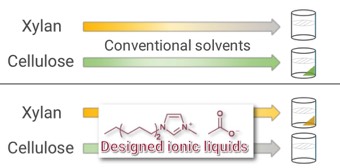
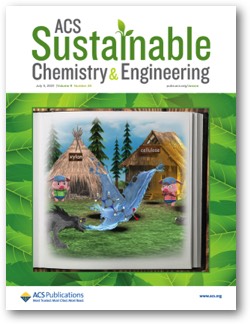
42.
Polar Zwitterion/Saccharide-Based Deep Eutectic Solvents for Cellulose Dissolution
G. Sharma, K. Takahashi, K. Kuroda*
Carbohydr. Polym., 267, 118171, (2021)
Most zwitterions are solid. We applied a method of deep eutectic solvent to zwitterions to make them liquid. The mixtures of zwitterions and sugars dissolved cellulose.
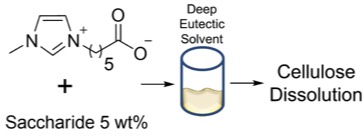
41.
High loading of trimethylglycine promotes aqueous solubility of poorly water-soluble cisplatin
R. Kadokawa, T. Fujie, G. Sharma, K. Ishibashi, K. Ninomiya, K. Takahashi, E. Hirata*, K. Kuroda*
Sci. Rep., 11, 9770 (2021)
Open Access
Cisplatin, a hydrophobic anti-cancer drug, was solubilized by 50 wt% trimethylglycine aqueous solution. Trimethylglycine is known as a biocompatible compound, indicating the solution is safe.
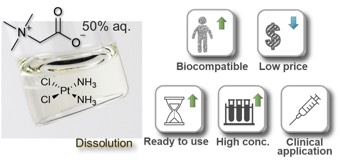
40.
Zwitterionic compounds are less ecotoxic than their analogous ionic liquid
F. Jesusa, H. Passos, A. M. Ferreira, K. Kuroda, J. L. Pereira, F. Gonçalves, J. A. P. Coutinho, S. P.M. Ventura*
Green Chem., 23, 3683-3692 (2021)
Zwitterionic compounds were less ecotoxic than their analogous ionic liquids, confirmed by toxic test using two kinds of mirooganisms.
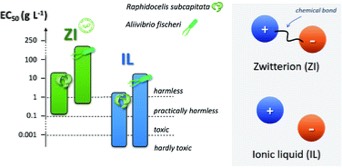
39.
Non-aqueous, zwitterionic solvent as an alternative for dimethyl sulfoxide in the life sciences
K. Kuroda*, T. Komori, K. Ishibashi, T. Uto, I. Kobayashi, R. Kadokawa, Y. Kato, K. Ninomiya, K. Takahashi, E. Hirata*
Commun. Chem., 3, 163 (2020)
Open Access
Dimethyl sulfoxide is a commonly used solvent, but its permeability and effect on cells is problematic. Here, an alternative solvent, a zwitterion-type ionic liquid and its plasma membrane affinity as well as cryo-protecting property and drug-dissolution ability are reported.
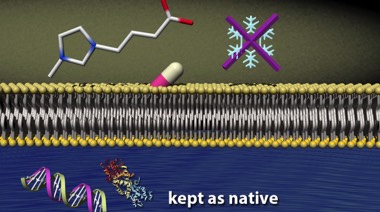
38.
Direct preparation of gels from herbal medicinal plants by using a low toxicity liquid zwitterion
C. Kodo, K. Kuroda*, K. Miyazaki, H. Ueda, K. Ninomiya, K. Takahashi
Polym. J., 467-472 (2020)
Free for view-only version
Herbal gels containing medicinal ingredients of licorice were formed by dissolving into a biocompatible zwitterionic cellulose solvent and successive precipitation. The licorice gels gradually released glycyrrhizic acid, the main medicinal ingredient of licorice, within 3 h. Although the licorice gels were mechanically weak, gel strength was improved just by adding cellulose during the preparation of the gels.
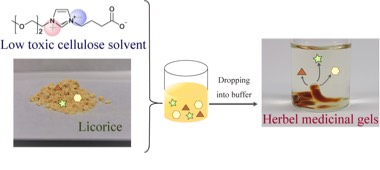
37.
Examining the unique retention behavior of volatile carboxylic acids in gas chromatography using zwitterionic liquid stationary phases
H. Nan, K. Kuroda, K. Takahashi, J. L. Anderson*
J. Chromatogr. A, 1603, 288-296 (2019)
Sulfonate-type liquid zwitterions were applied to stationary phases of gas chromatography. Volatile carboxylic acids were well separated by means of the stationary phases.
36.
Flame-retardant plant thermoplastics directly prepared by single ionic liquid substitution
R. Nishita, K. Kuroda*, S. Suzuki, K. Ninomiya, K. Takahashi
Polym. J., 51, 781-789 (2019)
Grass and wood biomass (bagasse, cedar, and eucalyptus) were directly converted to flame-retardant thermoplastics by dissolution in an ionic liquid mixture and successive precipitation. During dissolution, the hydroxy groups of the biomass were substituted with a phosphonate-type ionic liquid.

35.
Zwitterionic polymeric ionic liquid-based sorbent coatings in solid phase microextraction for the determination of short chain free fatty acids
I. Pacheco-Fernandez, M.J. Trujillo-Rodriguez, K. Kuroda, A.L. Holen, M.B. Jensen, J.L. Anderson*
Talanta, 200, 415-423 (2019)
Five different zwitterionic sorbent coatings based on polymeric ionic liquids were developed by the on fiber UV co-polymerization of the zwitterionic monomers and different dicationic ionic liquid crosslinkers. The developed sorbent coatings were applied in headspace solid-phase microextraction in combination with gas chromatography-mass spectrometry for the determination of short chain free fatty acids in wine. The best fiber required lower extraction times, exhibited higher reproducibility, and was more tolerant to ethanol present within the sample. The zwitterionic poly(ionic liquid)s were also applied for the analysis of red wine and fatty acids were quantified.
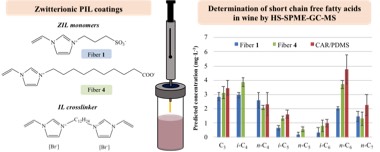
34.
Hand-holding and releasing between the anion and cation to change their macroscopic behavior in water
K. Kuroda*, Y. Shimada, K. Takahashi
Green Energy Envrion., 4, 127-130 (2019)
Open Access
Invited
We developed a novel phosphonium-type salt which has a dynamic covalent bond. The structure of the salt reversibly shifts between free ion pair and zwitterion by pH change or gas bubbling. The structural shift causes the change in phase behavior in the salt aqueous solution, i.e. reversible change between single- and two phase systems. This is an interesting example that a covalent bond—change at molecular level—gives rise to macroscopic change in phase behavior.

33.
Flame-retardant thermoplastics derived from plant cell wall polymers by single ionic liquid substitution
R. Nishita, K. Kuroda*, S. Ota, T. Endo, S. Suzuki, K. Ninomiya, K. Takahashi
New. J. Chem., 43, 2057-2064 (2019)
Front Cover
We proposed flame retardant thermoplastics derived from plant-based polymers by substitution with single phosphonate-type ionic liquid species. The ionic liquid plays roles of both “plasticizer” and “flame retardant”. Therefore we successfully left 66% of unreacted hydroxyl groups as it is after functionalization of the polymers, leading to further functionalization.
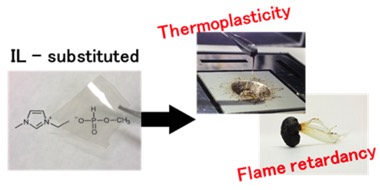
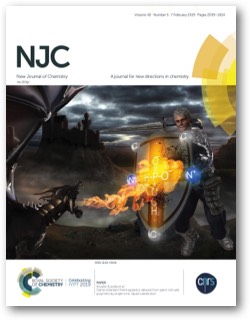
32.
A polar liquid zwitterion does not critically destruct cytochrome c at high concentration: an initial comparative study with a polar ionic liquid
K. Kuroda*, C. Kodo, K. Ninomiya, K. Takahashi
Aust. J. Chem., 72, 139-143 (2019)
Stability of cytochrome c in a liquid zwitterion, which dissolves cellulose but is very biocompatible, was investigated. Compared to a typical cellulose dissolving ionic liquid, the liquid zwitterion was compatible to cytochrome c under high ion concentration/high temperature.
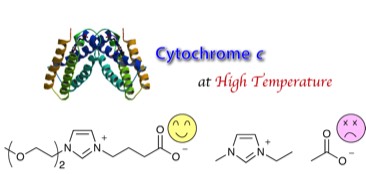
31.
CO2-triggered fine tune of electrical conductivity via tug-of-war between ions
K. Kuroda*, Y. Shimada, K. Takahashi
New J. Chem., 42, 15528-15532 (2018)
Front Cover
A novel approach to control electrical conductivity using CO2 was proposed by a reversible shift of molecular structures between free ions and zwitterions. It was achieved by a new design of ionic liquids, possessing dynamic covalent bonds between anions and cations. The conductivity was finely tuned by changing the partial pressure of CO2.
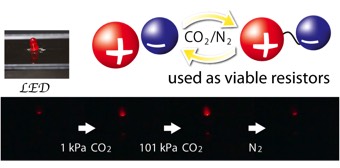
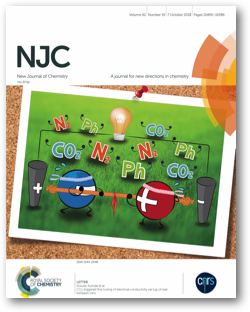
30.
Cellulose Structural Change in Various Biomass Species Pretreated by Ionic Liquid at Different Biomass Loadings
T. Endo, S. Fujii, E. M. Aung, K. Kuroda, T. Tsukegi, K. Ninomiya, K. Takahashi
BioResources, 13, 6663-6677(2018)
Biomass was pretreated by a carboxylate-type ionic liquid at various loading. Around 25-33 wt% of loading did not prevent efficient hydrolysis of cellulose. This results were also supported by the change of the crystallinity of cellulose before and after pretreatment.
29.
Dimethyl sulfoxide enhances both cellulose dissolution ability and biocompatibility of a carboxylate-type liquid zwitterion
H. Satria, K. Kuroda*, Y. Tsuge, K. Ninomiya, K. Takahashi
New. J. Chem., 42, 13225-13228 (2018)
Front Cover
Cellulose dissolution ability of a liquid zwitterion, the most biocompatible cellulose solvent, was improved by adding a co-solvent, dimethylsulfoxide. Moreover, biocompatibility of the liquid zwitterion was also improved by adding dimethylsulfoxide although it is toxic relative to the liquid zwitterion. The mixture is the efficient and extremely biocompatible cellulose solvent.
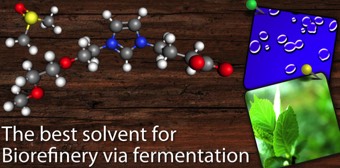
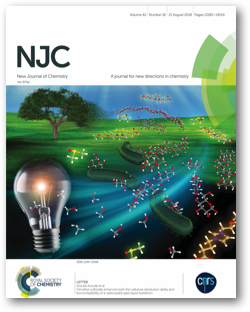
28.
Butylated lignin as a compatibilizing agent for polypropylene–based carbon fiber-reinforced plastics
H. Sakai, K. Kuroda*(co-first author), T. Tsukegi, T. Ogoshi, K. Ninomiya, K. Takahashi*
Polym. J., 50, 997-1002, (2018)
Free for view-only version
Butylated lignin was applied as a compatibilizing agent of polypropylene-based carbon fiber-reinforced plastics. The butylated lignin increased the tensile strength of the carbon fiber-reinforced plastic from 37.1 to 40.2 MPa, which was similar to what was achieved with a well-known oil-based compatibilizing agent (40.9 MPa).
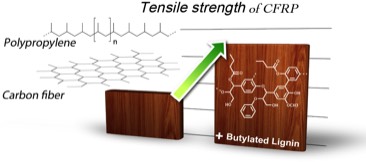
27.
Efficient pretreatment of bagasse at high loading in an ionic liquid
E. M. Aung, T. Endo, S. Fujii, K. Kuroda, K. Ninomiya, K. Takahashi
Ind. Crops Prod., 119, 243-248 (2018)
Efficiency of pretreatment of bagasse at high loading was investigated. When highly loaded (33 wt%), the crystallinity of bagasse was lower than that when low loaded (5 wt%). Consequently, the acid hydrolysis reaction of bagasse at high loading was proceeded efficiently.
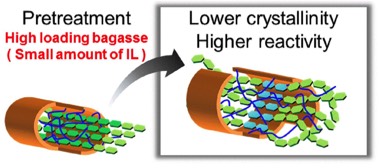
26.
Application of microalgae hydrolysate as a fermentation medium for microbial production of 2-pyrone 4,6-dicarboxylic acid
A. N. Htet, M. Noguchi, K. Ninomiya*, Y. Tsuge, K. Kuroda, S. Kajita, E. Masai, Y. Katayama, K. Shikinaka, Y. Otsuka, M. Nakamura, R. Honda, K. Takahashi
J. Biosci. Bioeng., 125, 717-722 (2018)
Microalgae was examined as a fermentation substrate for microbial production of 2-pyrone 4,6-dicarboxylic acid (PDC). Interestingly, 0.17 g/L PDC was produced even without additional nutrient because microalgae hydrolysate works as not only a carbon source but also nutrients required for microbial growth and fermentation.

25.
Structural Analysis of Zwitterionic Liquids vs. Homologous Ionic Liquids
B. Wu, K. Kuroda, K. Takahashi*, E. Castner, Jr.*
J. Chem. Phys., 148, 193807 (2018)
We investigated differences of bulk strucutres between zwitterionic liquids and ionic liquids: they have different factors to form nano domains. Additionally, longer spacer makes nature of zwitterionic liquids close to ionic liquids. It might indicates that the borderline between them is ambiguous.
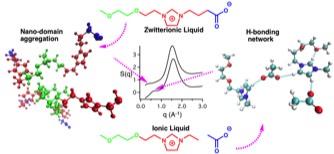
24.
Oxidative depolymerization potential of biorefinery lignin obtained by ionic liquid pretreatment and subsequent enzymatic saccharification of eucalyptus
K. Ninomiya*, K. Ochiai, M. Eguchi, K. Kuroda, Y. Tsuge, C. Ogino, T. Taima, K. Takahashi
Ind. Crops Prod., 111, 457-461 (2018)
Lignin, which was isolated from biomass by pretreatment with an ionic liquid and enzymatic digestion, was degraded with alkali nitrobenzene oxidation. The yield of sum of vanillin and syringaldehyde was 48.0%. The yields from lignin pretreated by diluted acid and soda lignin were 36.6 and 29.0%, respectively.
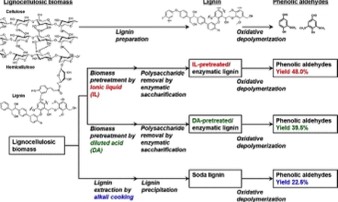
23.
Lignocellulose nanofibers prepared by ionic liquid pretreatment and subsequent mechanical nanofibrillation of bagasse powder: Application to esterified bagasse/polypropylene composites
K. Ninomiya*, M. Abe, T. Tsukegi, K. Kuroda, Y. Tsuge, K. Taki, T. Taima, J. Saito, M. Kimizu, K. Uzawa, K. Takahashi
Carbohydr. Polym., 182, 8-14 (2018)
Bagasse was nanofibrilized and esterified after pretreatment with choline acetate. The pretreatment improved toughness of the composite with polypropylene.
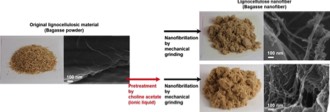
22.
Pretreatment of bagasse with a minimum amount of cholinium ionic liquid for subsequent saccharification at high loading and co-fermentation for ethanol production
K. Ninomiya*, A. R. I. Utami, Y. Tsuge, K. Kuroda, C. Ogino, T. Taima, J. Saito, M. Kimizu, K Takahashi
Chem. Eng. J., 338, 657-663 (2018)
Bagasse was pretreated with only small amount of choline acetate, and then converted to ethanol.
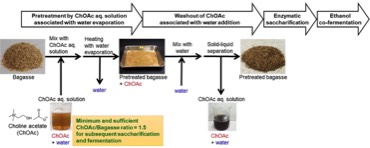
21.
Alkylated alkali lignin for compatibilizing agents of carbon fiber reinforced plastics with polypropylene
H. Sakai, K. Kuroda*(co-first author), S. Muroyama, T. Tsukegi, R. Kakuchi, K. Takada, A. Hata, R. Kojima, T. Ogoshi, M. Omichi, K. Ninomiya, K. Takahashi
Polym. J., 50, 281-284 (2018)
Free for view-only version
To improve compatibility between polypropylene and carbon fiber, we added alkylated lignin as a compatibilizing agent. The interfacial shear strength between them was improved from 8.2 to 17.2 MPa. This value is comparable to that with well-known compatibilizing agent (18.3 MPa).
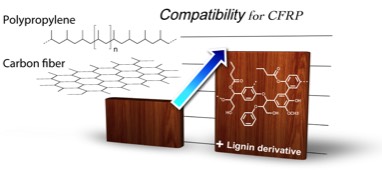
20.
Design of Wall-Destructive but Membrane-Compatible Solvents
K. Kuroda*, H. Satria, K. Miyamura, Y. Tsuge, K. Ninomiya, K. Takahashi
J. Am. Chem. Soc., 139, 16052-16055 (2017)
Supplementary Cover
A novel carboxylate-type liquid zwitterion (liquid below room temperature) showed both cellulose dissolution ability and extremely high compatibility to E. coli. We then constructed a new route for biorefinery: one-pot conversion from biomass to ethanol without adding excess amount of water.
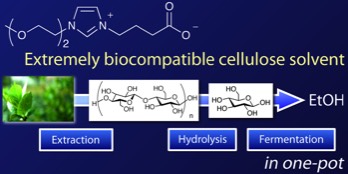
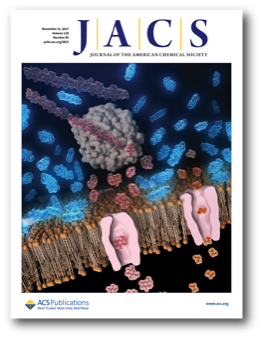
19.
Ionic liquid pretreatment of bagasse improves mechanical property of bagasse/polypropylene composites
K. Ninomiya*, M. Abe, T. Tsukegi, K. Kuroda, M. Omichi, K. Takada, M. Noguchi, Y. Tsuge, C. Ogino, K. Taki, T. Taima, K. Uzawa, K. Takahashi
Ind. Crops Prod., 109, 158-162 (2017)
Bagasse powder was esterified after pretereatment by a choline-type ionic liquid. The composite of polypropylene and the esterified bagasse with pretreatment showed good mechanical properties, compared to the case using an esterified bagasse without pretreatment.
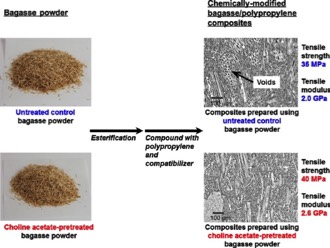
18.
Viscosity Effect of Ionic Liquid-Assisted Controlled Growth of CH3NH3PbI3 Nanoparticle-based Planar Perovskite Solar Cells
M. Shahiduzzaman*, K. Yamamoto, Y. Furumoto, K. Yonezawa, K. Hamada, K. Kuroda, K. Ninomiya, M. Karakawa, T. Kuwabara, K. Takahashi, K. Takahashi, T. Taima*
Org. Electron., 48, 147-153 (2017)
By using various ionic liquids, size and morphology of the CH3NH3PbI3 crystals were controlled and uniformly distributed CH3NH3PbI3 nanoparticle thin films were obtained.
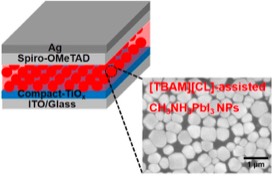
17.
Efficient Hydrolysis of Lignocellulose by Acidic Ionic Liquids under Low-Toxic Condition to Microorganisms
K. Kuroda*, K. Inoue, K. Miyamura, K. Takada, K. Ninomiya, K. Takahashi*
Catalysts, 7, 108 (2017)
Open Access
Efficient hydrolysis of lignocellulose was achieved in highly dilute acidic ionic liquid solution. A fermentative microorganism grew in the solution, indicating that the present method enables successive hydrolysis and fermentation.
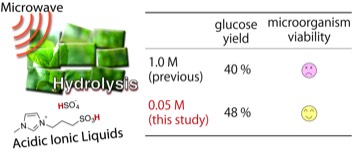
16.
Renaturation of cytochrome c dissolved in polar phosphonate-type ionic liquids using highly polar zwitterions
K. Kuroda*, Y. Kohno, H. Ohno
Chem. Lett., 46, 870-872 (2017)
By adding highly polar zwitterions, denatured cytochrome c in polar phosphonate-type ionic liquids was renatured.
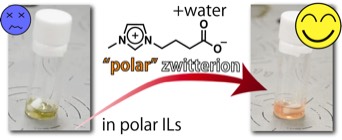
15.
Effective Dissolution of Biomass in Ionic Liquids by Irradiation of Non-thermal Atmospheric Pressure Plasma
K. Kuroda*, K. Shimomura, T. Ishijima, K. Takada, K. Ninomiya, K. Takahashi*
Aust. J. Chem., 70, 731-734 (2017)
By irradiating atmospheric pressure plasma, biomass was efficiently dissolved into ionic liquids. Chemical active species generated by plasma irradiation were effective to deconstruct lignin.
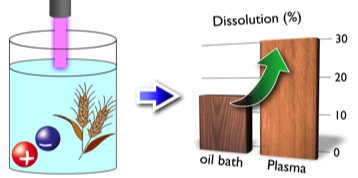
14.
Efficient recovery of ionic liquid by electrodialysis in acid hydrolysis process
T. Endo, M. Tatsumi, K. Kuroda, H. Satria, Y. Shimada, K. Ninomiya, K. Takahashi*
Sep. Sci. Technol., 52, 1240-1245 (2017)
Acidic ionic liquids from hydrolyzate of biomass were recovered by electrodialysis. By application of the acidic ionic liquids as electrolytic solutions, high recovery ratio was obtained.
13.
Efficient hydrolysis of polysaccharides in bagasse by in situ synthesis of an acidic ionic liquid after pretreatment
H. Satria, K. Kuroda*(co-first author), T. Endo, K. Takada, K. Ninomiya, K. Takahashi*
ACS Sustain. Chem. Eng., 5, 708-713 (2017)
While acidic ionic liquids are known as efficient catalyst for cellulose hydrolysis, the acidic ionic liquids cannot disrupt cellulose crystalline structure, resulting in low sugar yield. Therefore we first disrupted cellulose structure by sulfuric acid, which is a component of acidic ionic liquids, and then added zwitterion to the solution to synthesize acidic ionic liquids “in situ”. After hydrolysis, sugars were obtained with high yield.
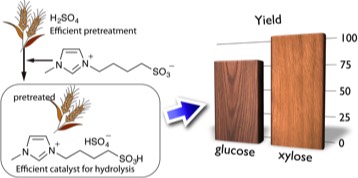
12.
Hydrolysis of cellulose using an acidic and hydrophobic ionic liquid, and subsequent separation of glucose aqueous solution from the ionic liquid and 5-(hydroxymethyl)furfural
K. Kuroda*, K. Miyamura, H. Satria, K. Takada, K. Ninomiya, K. Takahashi*
ACS Sustain. Chem. Eng., 4, 3352-3356 (2016)
Cellulose was hydrolyzed with an acidic and hydrophobic liquid. The ionic liquid and glucose aqueous solution were independently recovered easily. 5-(Hydroxymethyl)furfural, a fermentation-inhibitory compound which is generated during hydrolysis, was absorbed from the aqueous phase to the ionic liquid phase. Therefore, theoretically fermentable glucose solution was obtained directly.
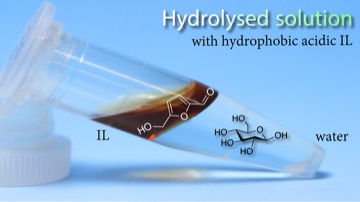
11.
Enhanced Hydrolysis of Lignocellulosic Biomass Assisted by a Combination of Acidic Ionic Liquids and Microwave Heating
K. Kuroda, K. Inoue, K. Miyamura, K. Takada, K. Ninomiya, K. Takahashi*
J. Chem. Eng. Jpn., 49, 809-813 (2016)
Cellulose was efficiently hydrolyzed by combining acidic ionic liquids and microwave heating.
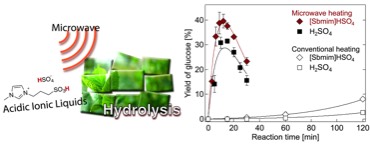
10.
Effects of polarity, hydrophobicity, and density of ionic liquids on cellulose solubility
M. Abe, K. Kuroda (co-first), D. Sato, H. Kunimura, H. Ohno*
Phys. Chem. Chem. Phys., 17, 32276-32282 (2016)
We have synthesised novel ionic liquids (ILs) to show both cellulose dissolution ability and LCST-type phase transition after mixing with water. To realise both polar and hydrophobic properties, tetraalkylphosphonium cations and a series of carboxylate anions were employed to assume hydrophobic and highly polar properties, respectively.
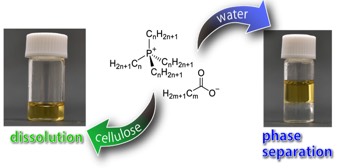
9.
Polar ionic liquid enables accurate chromatographic analysis of polyelectrolytes
K. Kuroda, H. Ohno*
Chem. Commun., 51, 10551-10553 (2015)
The molecular weight distribution of polyelectrolytes was determined with high performance liquid chromatography using ionic liquids as eluents, because the electrostatic repulsion among polyelectrolytes was entirely suppressed in it. A mixed sample of polycation and polyanion was also analysed to detect them independently.
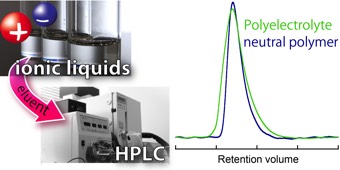
8.
Molecular weight distribution of polysaccharides and lignin extracted from plant biomass with a polar ionic liquid analysed without derivatisation process
K. Kuroda, Y. Fukaya, T. Yamada, H. Ohno*
Anal. Methods, 7, 1719-1726 (2015)
“Cover article & Hot Paper” selected by Anal. Methods
Molecular weight distribution of polysaccharides extracted with ionic liquids was directly analysed using high performance liquid chromatography with ionic lqiuids as eluents, and its relation to extraction condition was revealed.
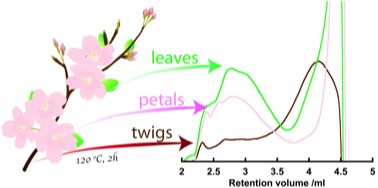
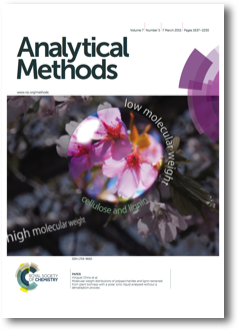
7.
Maintenance-free cellulose solvents based on onium hydroxides
M. Abe, K. Kuroda, H. Ohno*
ACS Sustain. Chem. Eng., 3, 1771-1776 (2015)
Tetraalkyl-onium hydroxide aqueous solutions are found to be maintenance-free cellulose solvents, and the 13C NMR measurement is found to be a very useful tool to forecast their cellulose-dissolving ability.

6.
Saccharification and ethanol fermentation from cholinium ionic liquid-pretreated bagasse with a different number of post-pretreatment washings
K. Ninomiya, S. Omote, C. Ogino, K. Kuroda, M. Noguchi, T. Endo, R. Kakuchi, N. Shimizu, K. Takahashi*
Bioresour. Technol., 189, 203-209 (2015)
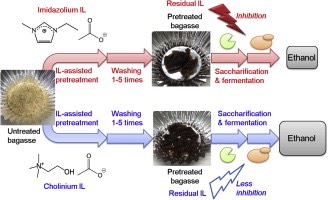
5.
Application of a Non-thermal Atmospheric Pressure Plasma Jet to the Decomposition of Salicylic Acid to Inorganic Carbon
K. Kuroda, T. Ishijima, T. Kaga, K. Shiomomura, K. Ninomiya, K. Takahashi*
Chem. Lett., 44, 1437-1475 (2015)
A non-thermal atmospheric pressure plasma jet technique was applied to decompose salicylic acid to inorganic carbon. Excess amount of hydroxyl radical, which has a high oxidation potential, decomposed salicylic acid within 10 min, and total organic carbon decreased to 20% after 30 min.
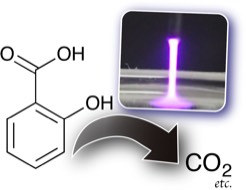
4.
1H NMR Evaluation of Polar and Nondeuterated Ionic Liquids for Selective Extraction of Cellulose and Xylan from Wheat Bran
K. Kuroda, H. Kunimura, Y. Fukaya, N. Nakamura, H. Ohno*
ACS Sustain. Chem. Eng., 2, 2204-2210 (2014)
Cellulose and xylan extracted from bran with polar ionic liquids were directly quantified with the aid of 1H NMR.
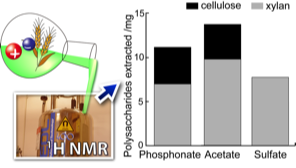
3.
1H NMR analysis of cellulose in ionic liquids
K. Kuroda, H. Kunimura, Y. Fukaya, H. Ohno*
Cellulose, 21, 2199-2206 (2014)
1H NMR spectroscopy of cellulose in a non-deuterated pure ionic liquid was analysed by using a combination of No-D NMR and a solvent suppression technique (WET) for investigation of interactions.
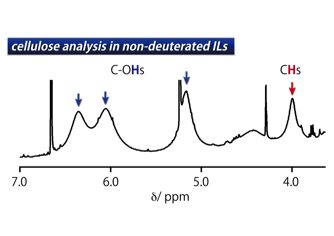
2.
Direct HPILC Analysis on Cellulose Depolymerisation in Ionic Liquids
K. Kuroda, Y. Fukaya, H. Ohno*
Anal. Methods, 5, 3172-3176 (2013)
“Cover article & Hot Paper & Most downloaded article” selected by Anal. Methods
High performance liquid chromatography with a ionic liquid as an eluent revealed the change of molecular weight distribution of cellulose during depolymerisation for mechanism speculation in ionic liquids.
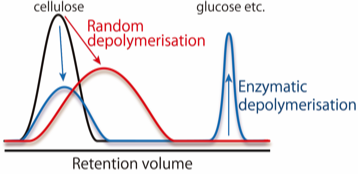

1.
High performance “ionic liquid” chromatography
Y. Fukaya, A. Tsukamoto, K. Kuroda, H. Ohno*
Chem. Commun., 47, 1994-1996 (2011)
“Hot Paper” selected by Chem. Commun.
We firstly developed high performance liquid chromatography methods with “ionic liquids” as eluents (HPILC) and successfully demonstrated the analysis of various biopolymers including scarcely soluble highly polymerized cellulose by means of HPILC with highly polar ionic liquid.
